| Disclosure: Just to be open and honest the buttons and links you click on in the website will in most cases take you to another website where you can purchase the products I am reviewing. As an Amazon Associate I earn from qualifying purchases. |
How to Choose a Fly Fishing Combo – Some Tips for the Newbie
Like all things in fly fishing, there are many options to choose from, fly fishing combos are no exception.
Fly fishing combo setup is a full kit designed specifically by the manufacturers to encourage beginners to the sport of fly fishing.
These manufacturers have put together a fly fishing rod, fly fishing reel fully loaded with backing line, a fly fishing forward floating line and possibly accessories including flies, fly box, sunglasses and a carrying case.
How to choose a fly fishing combo for beginners and knowing where to start in the sport can prove to be difficult.
Some come to the sport because they have seen some of their friends try it or seen it on TV or whatever but their exact notion of where and when to start fishing is somewhat elusive to them.
However, it’s important to know what type of fishing you want to do.
If it’s because you have been watching fishing on TV or seen your mates fly fishing them you may follow them but ideally, you want to know what type of fishing you want to do because the rod and reel need to match that aspect of the sport.
For instance, fishing for trout in a small stream will only require maybe an 8-foot or a 9-foot weight 4 or 5 fly rods.
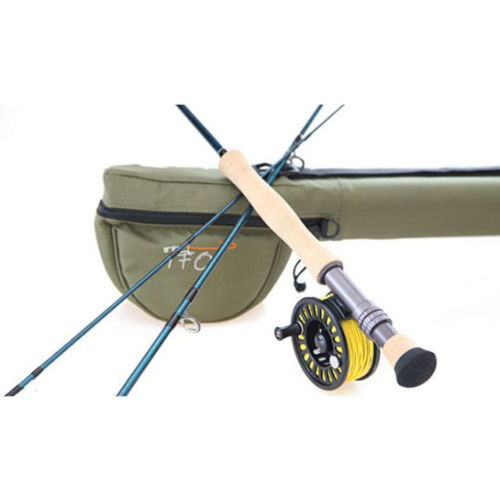
However, fishing onshore into salt water with an onshore wind will require an 8-weight 10ft rod to give you enough backbone to get your fly out into the breakers.
There are many set-ups available on the market today and they start anywhere from a 7 foot 4 weight up to 11 foot 8-9 weight.
To the new beginner that may not seem like a lot but that difference of four feet will mean a big difference when you’re trying to fish a large rod in a small river as the foliage gets in the way of your swing.
So when you’ve got the notion in your head as to which you’re going to do be it fishing for trout in a small river, fishing for them in a bigger river, fishing for them in stillwater or fishing the saltwater off the shore there are numerous other options to choose from but for this article, we will concentrate on small river trout rod of 9 foot 5 weight.
So we have decided we’re going to fish for trout on a small river when I mean small river that means one that we can cast across from banking into the opposite banking easily with the fly rod in which case the 9ft 5 weight will be ideal.
On the 9 foot 5 weight set-ups available to us it comes down to a matter of budget because the manufacturers out there have put together balanced setups.
Some may be a bit more advanced than others in the materials used and in the quality of the rods and reels in which case the price will reflect that.
However, all the set-ups are usually balanced in which the fly rod matches the five-weight reel along with the 5 weight fly fishing line, all matched to work together very well.
After all the manufacturers don’t want to put off newbies but encourage them to buy more gear as they get more advanced in the sport.
It’s in their interest to produce good combos for these newbies to start out on.
These are all put together and loaded onto the reel with good quality fishing knots so the set-up is ready to fish all you need to do is basically add water add possibly some flies depending on the combo you buy.
Other kits out there will come with extra accessories as in a box of fly fishing flies, nippers forceps, zingers for your fly vest, sunglasses, and maybe a rod carry case
to hold all your items.
These extra items are more of a selling point than being practical but that depends on what type of fish are you going to do.
They may or may not be useful to you sometimes the flies that come in the boxes are not much use for certain types of fly fishing.
However, some manufacturers have come up with a series of combos and they are matched and balanced to be able to fish in certain conditions like river, lake, saltwater etc.
These combos have flies suited for the task.
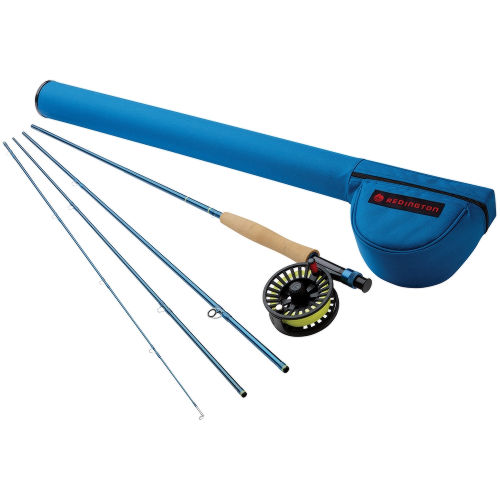
Quick Post Navigation
Combo fly fishing rods – What to look for
The main aspects of the fly rod to see how good it is are the weight, the material used to create it, the guides, the reel seat, sections, and action.
The lighter the fly rod the better as you will be able to cast much longer without getting fatigued.
This will cost however as the materials used to make light rods are usually kept for the top-of-the-line models.
Different manufacturers have different techniques in making rods and how the fibers are wrapped to form the taper etc, again the better tech will cost more so it’s a trade-off as to what you can afford to how good the actual rod is going to be.
Saying all this though the techniques used to make cheaper rods is getting better and better and now rods which perform very well are being produced on a good price.
Most rods come now in 4 sections. This makes it easier to transport and take with you on vacation or in the back of the car.
Some rods are shortened further and can have 6 or 7 sections usually called frequent flyers so they can go into the airplane with you.
However, the number of sections a rod has affects the action slightly as the rod is thickened at these points more than the rest so the flex is not continuous.
To a newbie, this will not make much of a difference but to the advanced angler, the way the action is transferred down the rod can make the difference.
The joints in rods are mostly over joins where the upper section slides down over the lower section.
Some will have alignment labels so you can align the rod correctly.
This helps in keeping the guide straight so the fly line goes out correctly.
If using a swing, switch or spey cast these sections will start to twist and open up.
It’s important that you check them regularly as they can fly open or worse get broken if a large fish hits you fly.
Guides come in several types mostly with single legs.
The main focus is the material used and to how smooth it is as the smoother the better so the fly line will move quickly through them.
The action of a fly rod is most important also, the faster the rod the quicker you need to be in timing between the backward and forward strokes in the cast.
This speed makes for tighter loops and further casting. Great for when you get more into the sport and need to cast into strong winds etc.
However, for a newbie, the medium to fast is better as the timing is slower and easier for a beginner to master.
Lastly, the reel seat can affect the overall strength and weight of the rod, some are made with wood and metal others are aluminum which is lighter and stronger.
Preferably a reel seat with two locking nuts is better to keep the reel in place.
Fly Fishing Beginner Combos – What do you need in the reel?
Not to go over old ground here you can check our reel buying guide here to see the properties that a good reel should have but to summarize here is a list of the options that make it good.
The more of these that are ticked the better although that will increase the price.

1 Lightweight – Less than 5oz is good
2 Large Arbor – Medium Arbor will hold more line but pick up less
3 Anti Corrosive – Anodized and protected
4 Seal disc drag – Keeps dirt and grit out of the mechanism
5 Strong – Strong so it doesn’t get damaged too easily when dropped
What fly fishing line is good for a combo fly fishing outfit?
As mentioned above manufacturers will match the rod, reel, and line to make it balanced.
However, some of those fly lines are pretty basic and an upgrade in line may be required after purchase to get more from the outfit. (would make better sense to go for a better combo).
Still some suppliers have developed a line specifically for the kit.
a) so they can produce cheaply and
b) make it unique to the kit and these are fairly decent lines.
Additional extras that come with fly fishing combos
The main things that come extra with a combo kit are the leader and flies.
The leader which is the section of tippet used to tie on flies can be cheaply produced and a spool of fluorocarbon bought after the combo can keep you going for a long time.
However, the drawback for a beginner is tying the knots. If a leader comes already on the kit you are almost ready to go. You just need to add the flies.
Flies come in all shapes and sizes and some suppliers have put more thought into it than others.
Some flies are designed to be used in a certain situation IE saltwater, rivers etc.
Some suppliers have added the flies in a waterproof fly box which is something that you can use for a long time after the flies have been destroyed by trout teeth or rocks and is a good addition.
The inclusion of tools like nippers used to cut tippets etc zingers used to attach tools to a wading jacket or vest, line straighteners, forceps, etc are worth having and can add a nice touch to a combo set if buying for a gift but I wouldn’t put any emphasis on them at this stage.
The bag that holds the kit or rod being well-made and having an extra pouch for you fly box and accessories is worth having though as this will protect your combo from the journey to and from the fishing.
If you are going to be doing long distances a tuff travel tube may be a better option as an extra but for the whole the cordura tubes will suffice for normal day to day journeys.
Conclusion on how to choose a fly fishing combo
So there you go a few tips on how to purchase a fly fishing combo.
First off you need to know what type of fishing you want to do follow that with what your budget is going to allow you.
When deciding the fishing make sure to allow the proper size of rod and reel to match the activity, as a general rule small light species will only need a small light setup.
If going after larger prey or difficult conditions a rod with more backbone is required.
The reel and fly line need to match these and in most cases as mentioned the manufacturers have taken care of that for you.
All that is left to do is make a purchase and go fishing.
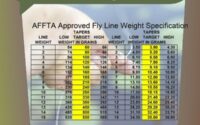
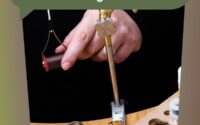
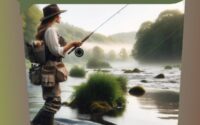
My husband has had fishing on his mind lately.
He would be a beginner and I know he loves salt water. I would love to give him a set as a gift. I want to make sure he has everything he needs, (as he would do the same for me).
I would want to start small, to give him the opportunity to pick other things.
I see you mention that in the ocean an 8 weight is required. Good tip.
Hey Zara if fly fishing in the sea I would recommend a higher rated rod as casting into the wind can be a big problem. A combo kit is ideal to start with as you have everything included to get fishing without the problem of balancing and matching the setup.
I must say that fly fishing is the best sport for calming your nerves. I enjoy when I go with dad to fish but now when I see this new fly fishing combos I must buy one for my dad. Although I go with my dad I am beginner and I think that Orvis Clearwater fly combo will suit me the best. Thank you friend for this awesome tips.
Hey Daniel the Orvis Clearwater Fly Combo is a great setup. Orvis have been issuing quality fishing tackle for almost 50 years now and anglers the world over know their tackle. You dad will be a happy boy I’m sure with it.
Hi there, thanks for posting this article. I’ve been fly fishing a few times but and really enjoyed it, despite not being overly great at it! I think with the tips here it will make for an even more enjoyable experience. I especially like that fact that the leader is part of the combo package – tying knots is always a bit of a problem for me! Thanks for the info.
Yes Richard, the fact the outfits come ready setup and balanced makes life so much easier for the novice. That is part of the sport that puts so many newbies off taking it up.
Hey Mark, your post was informative and awesome. Your post reminded how good it was to go fishing for the first time and I had a blast; I caught my first 14 inch bass which was great for a first timer. Your post inspired me to get back into fishing when the weather gets nice again. I loved your display of the fly fishing rods combos along with the accessories; your post was a great read. Awesome job!
Nice job on the 14 inch bass which would have been good fun on the fly rod. There is loads to choose from that is for sure. When you are back considering it give me a shout and i’ll assist as best I can.
Oh, this helps so much! Next summer when it’s warmer here, I think I might try some fly fishing. I’ve always loved the way it looks and thought it might be fun to try 🙂
Thank you so much for your article! I will be coming back to check what you’ve written before I buy. I want to make sure I get the right one for the large river we live near.
No problem Kaeyoes, give me a shout of you want some assistance.
I only have been fishing two times in my life and I remember I had so much fun. One of those times was with my kids. Of course we don’t know much about fishing, it’s more for fun, but these kits are awesome. Fly Fishing looks so cool and relaxing sport. Maybe for our next fishing day we can do something like this. Thanks for sharing.
As a family activity fly fishing can be great fun Andrea. I have two boys and they are just the age now to enjoy learning how to perform the overhead cast and try a spot of fly fishing.
I have a very good friend who is a fisher, I always wanted to go with him but he is such a bad teacher/explainer about it.
Also he is very clumsy so sometimes it ends up in a catastrophe.
So when we go to fishing, in this case, fly fishing, I’m going to pop up this post, also when I’m going to buy the stuff for it.
I read your post and it is a very good one, which will help me much more than he would do.
Thanks for sharing this post!
Thanks Emmanuel only too glad to help. If you get stuck give me a shout and I’ll hopefully get you sorted.
I’ve always wanted to do more fly fishing but it seems to me like there’s so many little technical bits and pieces to put together that it isn’t worth the effort. It’s great to see that there are products like these on the market that merge all the important bits into one package! So, the bigger rods are more suitable for more open water spaces and small rods for small rivers? Makes sense. Thanks!
Thanks Danny, bigger rods with a larger weight are better for larger waterways and shore fishing especially when facing an onshore wind. Combos are a definite plus for manufacturers to get folks into fly fishing. As mentioned it takes all the guesswork out of getting a setup ready for fly fishing.
Thanks for the great post. I’ve never been fly fishing before but it looked interesting and maybe just slightly more exciting than traditional fishing (at least your moving right?). I don’t know why but I just assumed you grabbed a rod a fly and go to town. Of course there are tons of options…there are in traditional fishing, why not fly fishing LOL.
I appreciate that you explain why certain lengths and weights are better for the type of fishing to be done (i.e. small stream vs saltwater shore, etc.).
Do you have an article on technique or a how-to type for beginners. I still want to give it a shot but I’m not really sure where to start in that respect.
Thanks again!
Hey Scott I have done a series on the website for casting. There is enough material there to get you started. If stuck give me a shout and I’ll guide you as best I can.
Thanks, I’ll check it out!
Scott
I’ve always been fascinated by Fly fishing, I’ve only ever seen it on the movies.
Thank you for this article, Gave me a closer look at everything one needs. I hope one day to actually experience Fly Fishing, and when I do. I will definitely be revisiting your website for more info.
Thanks again
Patty
Hey Patty, great to hear you are thinking about trying out fly fishing. It’s a great pastime and one I’m positive you will enjoy.
There are more and more women taking up the sport of fly fishing and I for one am glad. It’s nice to see the gentler sex on the rivers and streams, for one they are more conservation conscious and usually catch bigger fish, something to do with hormones I believe.
I love fishing and the outdoors. My grandfather gave me a bamboo fly rob when I was about 8 years old. I messed around with it for a little but never got the concept of it. Fly fishing is a hard sport. I like how provide plenty of information on many different types of fly rods. What is a good length to start out with?
Paul a good length to start with is a 9 foot 5 weight fly rod. It’s small enough to fish streams and big enough to be used on a lake.
Thanks for writing this great review about how to choose a fly fishing combo. It was very helpful. My brother in-law goes fly fishing all the time and I always wonder what I should get him for Christmas. I thought that I would get him some of your beginner suggestions, but now I am not so sure. When do you know that someone has “outgrown” beginner gear and needs to step it up to the next level? Thank you in advance.
Glenys, if he is an advanced angler a combo might not be the option for him. I’m assuming he will have rods and reels already. That being said a decent combo to take on trips is a nice addition to any anglers gear.
I see you have a few options go for one of the combos from the top category or go for a new fly rod or new fly reel for that you will need to find out what other gear he has so it will match the other rods and reels he already has. The combo is stand alone so it doesn’t really matter too much what full kit you get but a 9ft 5 weight is a decent all rounder.
What a great idea to buy a combo to get started.
It’s hard enough to learn the casting techniques and having the wrong gear to start makes it almost impossible. you could easily give up in frustration thinking it is your technique when it could be incorrect gear!
Very useful – thanks
Exactly right Lawrence, it’s much easier for a newbie to get into fly fishing to go out and buy a ready made up combo kit. That takes out all the guesswork out in getting the right pieces all to fit together correctly.
Ok, this was very interesting and just what we needed! We recently moved to Florida, and everyone here fishes in the ocean.
I know there are grouper about, and what else I am unclear. But, my son has been wanting a fly fishing rod so he can join the many anglers. I am not sure what fly fishing combo would work? Any suggestions?
Hi fly fishing for grouper now that’s not something I have tried myself yet. However I do know these fish can grow to a large size. You will probably need a fly rod in an 8 weight or higher especially if going after Goliath Grouper which can get up to 800 lbs.
I’m sure he is thinking of going after the smaller fish around the reefs. 5-10 lb in which case a 7-8 weight rod would be OK.
I would seek out local advice on the type of leader material and fly lines, also what flies they are using. I think you need to sink the fly line a bit to get to these species so how they are doing that will help him succeed.
I don’t think there is a combo on the market for this type of fishing as it is very specialized so a trip to the local tackle shop would be a better option to seek out advice.
Thank you so much for this post. I have recently moved to an area where fly fishing is really popular. So many people here (men, women and children) seem to love it and I know very little about it so I’ve been wanting to learn more about it. I appreciate so much that this post is “beginner friendly”!
Susie
Hi Susie, great to hear you are thinking of getting into fly fishing. There are so many ladies getting into the sport nowadays.
It used to be a male dominant sport but that has changed for the better I feel as ladies are gentler and usually more conservationally minded. Which can only be a good thing for us all moving forward and leaving something for the next generations to fly fish for.
You have decided to take up the sport at an optimum time as more and more manufacturers are producing products for ladies including waders, wading jackets, wading boots along with more lady friendly fly rods and reels.
I would recommend you get a guide to show you the ropes or someone who you know who is a decent fly angler. This way you will pick up the basics so much quicker than trying it on your own.
You could also check in your area if there is a ladies fly fishing club that you could go along to and maybe get some tution that way.
Tight Lines!
I have been bank and kayak fishing for using spinner rods and reels for quite a while now. I have just recently been starting to get an interest into fly fishing.
In the area I fish trout can’t spawn. They do stock trout at certain times of the year, but it is primarily a catfish, black bass, panfish area. I’m partial to bass and I am wondering if it would be worth trying fly fishing for black bass?
If it is what would be a good size fly rod for fishing bass in small lakes and creeks?
Hey CJ bass can get up to 12lb or more and an 8 weight is recommended however, if the area in which you are fly fishing for bass produces smaller fish as like in the hill creeks or streams then a 6-7 weight might be a better match for you.
Good solid info. I’m an avid fisherman but have yet to try fly fishing. I was wondering, in your opinion, which brand has the most bang for your buck in the $150 – $200 price range? Haven’t been for a while and I’m getting the itch.
Hey Jack the Orvis Encounter and the Redington Path are two good combos at that price point. Anyone will scratch that itch well enough.